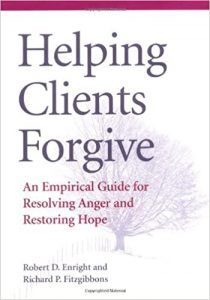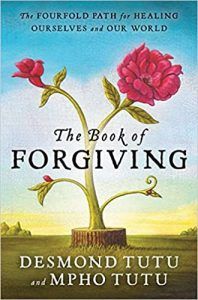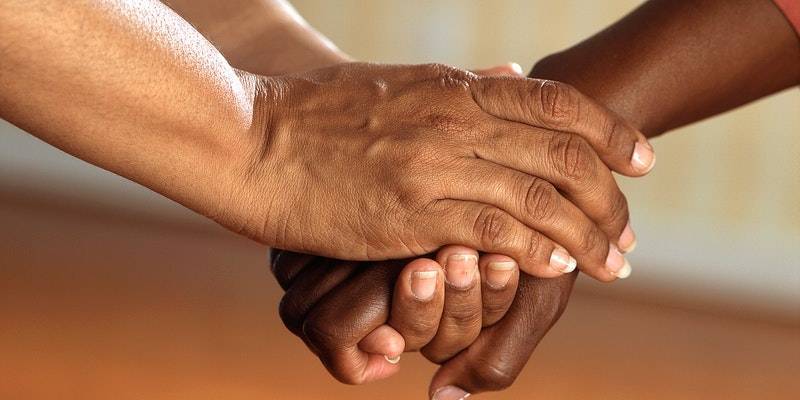Forgiveness Therapy: 6+ Techniques to Help Clients Forgive
 Do you value forgiveness?
Do you value forgiveness?
If so, you are probably living a happier and healthier life.
Forgiving someone who has done us harm or forgiving ourselves when we’ve made a mistake is perhaps the most critical step in healing and moving on.
Although we don’t often talk about forgiveness as a learned behavior, research reminds us that we can cultivate and execute it with practice. And for therapists, helping our clients to forgive themselves and others can put them on track toward self-healing, self-empowerment, and self-liberation.
Read on for an exploration of the clinical application of forgiveness and resources for further learning.
Before you continue, we thought you might like to download our three Self-Compassion Exercises for free. These detailed, science-based exercises will not only help you increase the compassion and kindness you show yourself but will also give you the tools to help your clients, students, or employees show more compassion to themselves.
This Article Contains:
- What Is Forgiveness in Strength Psychology?
- Is Forgiveness Important? 5 Benefits
- 3 Examples of Forgiveness
- Forgiveness Therapy: 3 Techniques to Help Clients
- 3 Useful Worksheets and Exercises
- Teaching Forgiveness to Kids
- Made a Mistake? 3 Ways to Forgive Yourself
- Tips and Affirmations for Forgiving Your Faults
- 3 Inspiring TED Talks and Videos
- 2 Books on the Topic
- PositivePsychology.com Resources
- A Take-Home Message
- References
What Is Forgiveness in Strength Psychology?
Strength psychology researchers have worked to define forgiveness. Forgiveness is not forgetting or condoning the harm that has been done; instead, it is letting go of the need for revenge and releasing negative thoughts of bitterness and resentment (Sanjay, Singh, & Hooda, 2019).
An older and more passive version of forgiveness is merely letting bygones be bygones: to allow time to pass as the injury becomes less relevant to everyday life. Instead, strength psychology uses the idea of radical forgiveness, in which the injured person makes a deep commitment to releasing the past (Sanjay et al., 2019).
Radical forgiveness involves a dual notion of taking concrete steps to forgive the offender, while also surrendering to the flow of life and ascribing meaning to the suffering experienced. Compared to passive forgiveness, radical forgiveness can occur more rapidly and concretely, but it also takes more energy and guidance.
Ultimately, forgiveness in strength psychology is about freedom for the injured person. Through gaining a more balanced view of the offender and the event, the individual can let go of the weight of negative emotions and the desire to punish and avenge.
The goal is not necessarily to restore the relationship or achieve reconciliation – however, these can certainly be positive outcomes – it is instead to restore personal wellbeing and balance to the injured person’s life.
Is Forgiveness Important? 5 Benefits
It depends on who you ask and the culture in which you live.
If we take a look at the United States, it is evident by the number of people serving life sentences in prisons that forgiveness is not highly valued, at least not by the criminal justice system.
Research is increasingly showing the benefits of forgiveness, and therapeutic interventions have been developed to help individuals heal themselves through the process of forgiveness. We’ll get to that later on in this post. For now, let’s talk about five benefits of forgiveness.
1. Forgiveness reduces negative affect
Holding a grudge feels terrible. According to recent meta-analyses on the effects of forgiveness therapy, forgiveness helped to minimize aspects of negative affect such as depression, anger, hostility, stress, and distress (Akhtar & Barlow, 2018).
2. Forgiveness promotes positive affect
Forgiveness can do a lot more than make us feel less bad. It can also increase our general levels of happiness, satisfaction, and compassion (Akhtar & Barlow, 2018).
3. Forgiveness provides freedom
People who cannot or do not forgive are often trapped in a storm of negative emotions and, at the extreme, may devote their entire lives to avenging their hurt. Forgiveness can provide freedom from an endless quest for revenge.
4. Forgiveness heals individuals
When you forgive someone, it is not always necessary to tell them about it. In this way, forgiveness can be solely for the healing and empowerment of the injured person.
5. Forgiveness can heal relationships
Sometimes the person who has committed the offense is an important or irreplaceable loved one. In cases where the injured individual wants to preserve their relationship, forgiveness may be the path toward this goal.
3 Examples of Forgiveness
Below we will share astounding real-life examples of forgiveness that will inspire you.
1. Eva Mozes Kor
Eva Mozes Kor is a survivor of the Auschwitz concentration camp. She and her twin sister were experimented on by Dr. Josef Mengele.
Almost 50 years after her liberation from the camp, Eva decided to forgive her torturer, in an act she described as “self-empowerment, self-healing, and self-liberation.” Eva Mozes Kor reminds us that we cannot change what happened, but we can change how we relate to it.
2. Sue Klebold
Sue Klebold is the mother of one of the shooters in the Columbine school shooting of 1999. Her story is one of seeking forgiveness both from the family members of her son’s victims and from herself for her perceived failure as a parent.
Klebold underwent a reconciliation process with the victims’ families and received a mixed reaction: while certain members found solace in forgiving her, others held fast to their anger. In her search for self-forgiveness, Klebold has dedicated her energy to educating others about mental illness and suicide.
3. Thordis Elva and Tom Stranger
Tom Stranger raped Thordis Elva when they were dating in high school. At the time, neither saw what occurred as rape, but after years of shame and self-blame, Elva decided to take action.
Elva saw forgiveness as her path to freedom and contacted Stranger. The two of them then underwent a process of communication and reconciliation. They share their story to help others find their paths toward healing and forgiveness.
Both of their stories are told here:
Forgiveness Therapy: 3 Techniques to Help Clients

There are many different types of forgiveness therapy, a few of which we will explore here, but they fall into two distinct categories: process-based and decision-based interventions (Akhtar & Barlow, 2018).
The two different camps’ critical distinctions are that process-based forgiveness interventions take place over a more extended period and use cognitive, behavioral, and affective strategies.
In contrast, decision-based forgiveness interventions are significantly shorter (sometimes only one session) and involve primarily cognitive strategies and a commitment to do the work of forgiving outside of the session (Akhtar & Barlow, 2018).
Regardless of which model is used, 12 or more forgiveness therapy sessions seem to be most effective (Akhtar & Barlow, 2018). The following models have been deemed adequate for a wide variety of interpersonal hurts across diverse groups of clients (Akhtar & Barlow, 2018).
Enright Model intervention
A popular process-based intervention is called the Enright Model (Enright & Fitzgibbons, 2000). This is a structured intervention that consists of 20 units and four phases.
- In the first phase – uncovering – the client is helped to understand the psychological defenses at work within them, recognize and acknowledge the anger they feel, and evaluate the psychological harm caused by the offense.
- In the second phase – decision making – the possibility of forgiveness as a response is explored, followed by a commitment to forgive.
- In the third phase – cognitive reframing of the offense – the client is helped to develop empathy for the offender and accept the pain experienced.
- In the final phase – deepening – clients are helped to find meaning in their suffering. (Akhtar & Barlow, 2018).
REACH Model
A type of decision-making forgiveness intervention is the REACH Model (Worthington, 2001). REACH is an acronym that describes the five steps of forgiveness involved in the intervention.
- First, participants recall (R) the hurt.
- Second, they develop empathy (E) for the offender.
- Third, participants reframe forgiveness as an altruistic (A) gift for the offender.
- Fourth, they commit (C) to forgive, and
- In the final step, they learn to hold on to (H) forgiveness (Akhtar & Barlow, 2018).
Forgiveness letter
Another example of a decision-based forgiveness intervention is one developed by McCullough and Worthington (1995). It is a brief forgiveness intervention, consisting of a single session in which the client decides to forgive.
The client then writes a letter of forgiveness to the offender. This intervention is markedly shorter than the others and has the effect of starting the process of forgiveness with the client, leaving them to continue the work on their own.
3 Useful Worksheets and Exercises
Radical acceptance is the realization that we cannot control others’ behavior, but we can control our reaction to the things that happen to us. It is a commitment to accept whatever situation comes to us, no matter how unpleasant. Only then can we take action, such as forgiveness. Use our Radical Acceptance Worksheet to help your clients develop this vital skill.
As you will read in our next section, children need help with forgiveness. Empathy is a teachable skill that will help children not only to forgive, but also to understand why it is important to forgive. Our What is Empathy Worksheet is useful for teaching children to develop this quality, helping them take a big step toward forgiveness.
Often we feel hurt when someone violates one of our “internal rules.” These rules can be adaptive or harmful and rigid, but it is essential to understand our rules. Forgiveness is a useful option when one of our rules has been violated. Our Cataloging Your Inner Rules worksheet can help you or your client understand where the hurt is so that the forgiving and healing process can begin.
Please see the final section of this post for more forgiveness-related activities and worksheets from our Toolkit.
Teaching Forgiveness to Kids

Most of us could use a basic education in forgiveness, so what follows does not apply only to children.
Jamie Perillo, LPC, (2018) makes several suggestions to help kids learn to forgive. First, it is important to help the child make the distinction between forgiving and forgetting. Forgiving does not mean condoning or encouraging the behavior.
Many adults also struggle with this particular aversion to forgetting, which stems from the fear that it will be more likely to happen again if they forgive the action. Instead, help the child see forgiveness as a way of saying, “I do not like what you did, but I will forgive you because it does not help me to hold on to these bad feelings” (Perillo, 2018).
Before helping the child forgive their offender, it is important to help them understand what has happened. To do this, help the child identify the feelings that they are experiencing because of the offense. Ask them to name the feeling. Helping the child identify the feeling can help them own their forgiveness rather than do it because they are told (Perillo, 2018).
Next, give the child something concrete to do. Perhaps this is talking directly to the offender. In other cases, a less direct approach may be warranted. For example, writing a letter explaining their hurt feelings and offering forgiveness, and then ripping it up can provide a release for the child (Perillo, 2018).
Made a Mistake? 3 Ways to Forgive Yourself
Self-forgiveness is a powerful action. It can have an effect in even the most extreme situations, including decreasing depression and suicide and increasing help-seeking behaviors and general mental wellbeing in firefighters and military veterans (Carpenter et al., 2020).
If self-forgiveness can work for the individuals working in these intense professions, there is a good chance that it can help both you and your clients. Try these three ways to forgive yourself (Snow, 1993):
1. Recognize and acknowledge that humans are complex and flawed beings.
There is not a person in the history of this world that hasn’t made a mistake. The recognition that making mistakes is a basic part of human nature can help you contextualize your mistakes and forgive yourself.
2. Reframe self-forgiveness as a step toward self-improvement.
Self-forgiveness does not need to occur in a moral context and can be used for self-improvement.
A potent example of this is a football player who fumbles the football (Snow, 1993). This player is bound to be filled with negative emotions after committing the error but has to make a quick recovery to still do their best on the next play. Self-forgiveness is a way to shed the negative emotions that hold us back to improve as we go along.
3. Consider self-forgiveness as second best to interpersonal forgiveness.
Sometimes interpersonal forgiveness is not possible or inappropriate, such as when the offended individual unreasonably withholds forgiveness or when the offense committed overcomes the individual’s capacity for forgiveness (Snow, 1993).
In these cases, negative emotions persist despite attempts at forgiveness, and self-forgiveness can be considered a second-best alternative. It is second best because it is one sided. It cannot repair the relationship, but it can restore feelings of personal wholeness. When forgiveness cannot occur, try self-forgiveness.
Tips and Affirmations for Forgiving Your Faults

If you have done something that you cannot forget, you may feel trapped and without options. Remember that there are many things you can do to help you move forward.
Here are some useful tips for forgiving yourself:
- Remember that self-forgiveness is an act of strength, not weakness.
- Self-forgiveness is always an option, even when someone will not forgive you.
- Self-forgiveness does not need to come at the expense of other actions, such as making amends or learning from your mistakes. It may increase your ability to take these steps.
If your mind still keeps turning over what happened, like a washing machine stuck in its cycle, try repeating these affirmations to yourself:
- I forgive myself for my past decisions and actions.
- I release anger, shame, guilt, and embarrassment.
- I trust myself to learn from this and build a better future.
3 Inspiring TED Talks and Videos
Let’s explore the concept of forgiveness and its application with a few fitting videos.
1. What Comes After Tragedy? Forgiveness, by Azim Khamisa and Ples Felix
This incredible story of two men who turned tragedy into forgiveness, and then turned their energies toward promoting forgiveness in society, is inspiring. If these men can forgive each other and work together for good, so can we all.
2. Why Forgiveness Is Worth It, by Sarah Montana
This TEDx Talk on forgiveness defines one person’s journey not to let one tragic moment define her entire life. In her speech, Sarah Montana described forgiveness as “designed to set you free,” saying to her offender, “I can heal myself, and I don’t need anything from you.”
3. The Mothers Who Found Forgiveness, Friendship by Aicha Al-Wafi and Phyllis Rodriguez
These two mothers, one whose son was killed in the 9/11 World Trade Center attacks, the other whose son was convicted of a role in the attacks, tell their story of finding freedom and connection through forgiveness.
2 Books on the Topic
If you want to know more about this topic, there is nothing quite like a good book. We share two recommended reads:
1. Helping Clients Forgive: An Empirical Guide for Resolving Anger and Restoring Hope – Robert Enright and Richard Fitzgibbons
This book was written by two of the pioneers of forgiveness work in psychotherapy.
This book is a helpful primer for any therapist hoping to help their clients forgive.
The book will help you realize when forgiveness is an appropriate client goal and how to introduce and explain forgiveness to your client. It also includes concrete exercises to help you get your client there.
Find the book on Amazon.
2. The Book of Forgiving: The Fourfold Path for Healing Ourselves and Our World – Desmond Tutu and Mpho Tutu
Written by the Chair of the South African Truth and Reconciliation Commission, Archbishop Tutu’s work helping to heal his country post-apartheid culminates in this book, which helps us realize that we are all capable of transformation and healing.
The book defines forgiveness as understanding that every one of us is inherently good and inherently flawed.
This is an especially interesting read for those interested in world politics and forgiveness on a societal scale.
Find the book on Amazon.
PositivePsychology.com Resources
If you are looking for resources on forgiveness that you can use with your clients, look no further than our Positive Psychology Toolkit©.
In the Toolkit, you can find plenty of resources (amongst the 400+ tools in the Toolkit) dedicated exclusively to helping your clients with forgiveness.
However, we have a few free worksheets you can access, such as the 4 Ds of Forgiveness worksheet, which introduces four steps of guidance through the forgiveness process.
On the other hand, the worksheet CONFESSing – Seeking Forgiveness provides a framework for asking forgiveness from others.
Besides the tools in out toolkit and the free worksheets, you might find this article very apt for further reading:
Forgiveness Activities, Exercises, Tips, and Worksheets – provides a combination of 24 additional tools to use with your clients.
If you’re looking for more science-based ways to help others develop self-compassion, this collection contains 17 validated self-compassion tools for practitioners. Use them to help others create a kinder and more nurturing relationship with the self.
A Take-Home Message
Forgiveness can be many things. In therapy, it often represents an act of individual freedom or a method of relationship repair. The concept is versatile and has many benefits for mental health and personal wellbeing.
When working with clients, it is essential to remember that forgiveness may not always be appropriate or wanted. Remember to give your client agency in the process, and let them be the one who decides they should forgive.
If your client wants to go down this road, the above resources should be an excellent start to the process.
We hope you enjoyed reading this article. Don’t forget to download our three Self Compassion Exercises for free.
- Akhtar, S., & Barlow, J. (2018). Forgiveness therapy for the promotion of mental well-being: A systematic review and meta-analysis. Trauma, Violence & Abuse, 19(1), 107–122.
- Carpenter, T. P., Pennington, M. L., Seebeck, J., Gomez, D. R., Denman, T. C., Kimbrel, N. A., … & Gulliver, S. B. (2020). Dispositional self-forgiveness in firefighters predicts less help-seeking stigma and fewer mental health challenges. Stigma and Health, 5(1), 29–37.
- Enright, R. D., & Fitzgibbons, R. P. (2000). Helping clients forgive: An empirical guide for resolving anger and restoring hope. Washington, DC: American Psychological Association.
- McCullough, M. E., & Worthington, E. L., Jr. (1995). Promoting forgiveness: The comparison of two brief psychoeducational interventions with a wait-list control. Counseling and Values, 40, 5568.
- Perillo, J. (2018). How to teach a child forgiveness. Psych Central. Retrieved on September 4, 2020, from https://psychcentral.com/blog/how-to-teach-a-child-forgiveness/.
- Sanjay, Singh, R., & Hooda, R. S. (2019). Forgiveness: A theoretical perspective. IAHRW International Journal of Social Sciences Review, 7(4), 687–689.
- Snow, N. E. (1993). Self-forgiveness. Journal of Value Inquiry, 27(1), 75–83.
- Tutu, D., Tutu, M. A., & Abrams, D. C. (Ed.) (2014). The book of forgiving: The fourfold path for healing ourselves and our world. New York, NY: Harper Collins.
- Worthington, E. L., Jr. (2001). Five steps to forgiveness: The art and science of forgiving. New York, NY: Crown.
Let us know your thoughts
Read other articles by their category
- Body & Brain (41)
- Coaching & Application (49)
- Compassion (27)
- Counseling (46)
- Emotional Intelligence (23)
- Gratitude (16)
- Grief & Bereavement (19)
- Happiness & SWB (35)
- Meaning & Values (26)
- Meditation (21)
- Mindfulness (42)
- Motivation & Goals (42)
- Optimism & Mindset (33)
- Positive CBT (24)
- Positive Communication (21)
- Positive Education (41)
- Positive Emotions (28)
- Positive Psychology (33)
- Positive Workplace (38)
- Relationships (31)
- Resilience & Coping (33)
- Self Awareness (21)
- Self Esteem (38)
- Software & Apps (23)
- Strengths & Virtues (28)
- Stress & Burnout Prevention (27)
- Theory & Books (42)
- Therapy Exercises (30)
- Types of Therapy (53)
 Is
Is 





What our readers think
No mention of self forgiveness
Forgiving someone maybe something very difficult to do but it just the right thing to do. Only time will tell and its not a good thing to hold grudges on anyone.
Thank you for this article! I have a client who says he can’t forgive himself for something he did. Hes only 13 and I really want him to know that he can forgive himself! This is helpful.
It wasn’t until I was able to truly understand forgiveness that I was able to change. Compared to self-forgiveness, forgiving others was easy! It was the self-forgiveness that kept me relapsing and going back to my “self-medicating” lifestyle of drugs and alcohol. Once I was able to truly forgive myself was I able to get into a long-lasting recovery program. As long as I continue to practice both self-forgiveness and forgiving others, and have a daily practice of gratitude, I know I can stay sober another day.
Thank you for your research. I am a student learning about how to counsel others. I find your resources are filled with a wealth of truth and apply greatly to the situations I and the others in my life struggle with. I especially found the Ted talk with Thordis and Tom Stranger interesting.